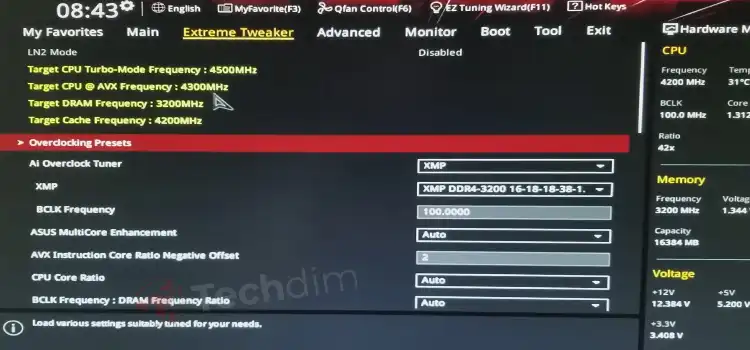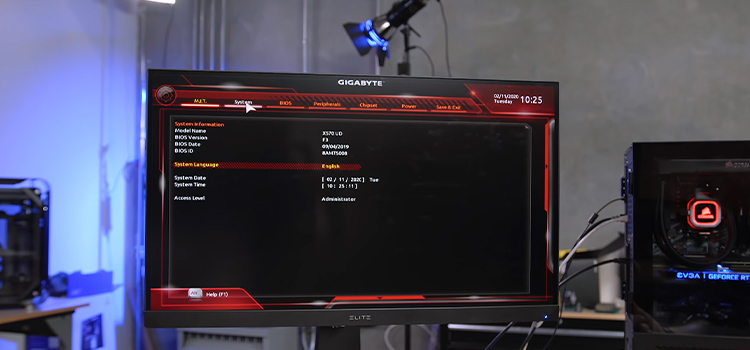How to Overclock I7 7700K Asus (Guide to Increase Clock Speed)
To overclock your I7 7000k process, first, go to your BIOS and open the Advanced Frequency Settings. Before increasing the CPU clock speed, reduce the memory bus speed. Then increase the CPU base clock by 10% and run a stress test. After that increase the multiplier by 0.5 and run a stress test again.
Then increase the CPU core voltage and while you are at it, keep an eye on the temperature. Make sure to get the most effective combination and keep the CPU stable. To know more about Overclocking i7 7700K Asus, keep digging further.

Does ASUS Allow Overclocking
Currently, almost all of the new CPUs and GPUs allow you to overclock to meet the insane demand of the current games. So if your CPU or GPU is not that old, you should not worry about overclocking. But it would be better to check for access as well as the safety limit, before getting started with it.
Should I Overclock Intel Core I7 7700K CPU
Every Intel process that has a K in the model name, is specifically designed to be overclocked. So, there will be no damage caused by overclocking the CPU. And you can expect a great increment in performance.
How to Overclock Intel Core I7 7700K Asus
To boost your PC’s overall performance, overclocking is one of the main preferences for most users. Overclocking means boosting the clock speed of your GPU or processor. And it is now well established that overclocked processor is more effective than overclocked GPU.
Overclocking has a lot of benefits. But if you don’t do it the right way, there will always be a risk of damaging your hardware. Also, if you are not careful about the process, you might face some overheating issues.

To guide you to the right way of overclocking the CPU, we have gathered all the information you will need to know before you start with the process.
Things to Do Before You Start Overclocking The I7 7700K
If you expect a certain level of increment in performance, you might get disappointed. Because the performance boost can get affected by the slightest variances. So, certain YouTube videos should not make up your expectation, even if you have the same hardware.
1. Install Benchmarking Programs
When you will be done with the overclocking process, you will require some benchmarking tools as well as some stress tools to find out the outcome of the overclocking process.
For the CPU stress test, you can try CoreTemp, IntelBurn, or AID64. To monitor the CPU performance, CPU-Z can be quite an efficient option for you. And for benchmarking, you can use Prime95.
2. Check The Hardware Specification
Before getting started with the overclocking, you should check both your motherboard as well as the processor’s specification. Firstly, check if the multiplier is locked or not. If it is locked, you would just be able to adjust the clock speed. And boosting the performance will not be much effective at that point.
However, since you have the Intel i7 7700K processor, any Intel processor that has the K in its model name, means that it is designed specifically to be overclocked.
3. Check Your Current Performance
If you want something to compare, run a stress test using your default settings. Save those results. And later on, when the overclocking will be done, you can compare and check the improvement.
Procedure for Overclocking Intel Core I7 7700K CPU
Step 1: Open BIOS
With BIOS, you can overclock your CPU most simply. To access BIOS, press the Delete key while booting the PC. Since every BIOS is different, you might find it hard to locate the settings.
Step 2: Open Advanced Frequency Settings
In your BIOS, you can find this Frequency settings option. It might be available under some other name. But it should vary from Frequency control to voltage control. From here, you can adjust the voltage along with the CPU speed.
Step 3: Lower the Memory Bus Speed
Before the overclocking gets started, make sure that the memory bus speed is reduced to its lowest level. To find out the option, you can either look for the DDR Memory Frequency/Memory Multiplier or press Ctrl+Alt+F1 on your BIOS.
Step 4: Increase the CPU Base Clock
At this point, increase the CPU base clock by 10% which is the base speed of your CPU. As your CPU is designed for overclocking process, this 10% speed jump will not cause any harm. After making even the slightest change in your BIOS while overclocking, you should run a speed test afterward.
So since you have increased the base clock by 10%, you should run a stress test and see if the system is stable or not.
After that, go back to the BIOS, and keep increasing the base clock speed. And after making the change to a certain bit, reboot and stress test to check if the system is stable or not. If it becomes unstable, go back to your previous settings and run a stress test again.
Step 5: Increase the Multiplier
While overclocking, your main target should be to get a more stable CPU. To help you to keep it stable, you can increase the multiplier to some point. But for that, you will have to lower your base clock speed a little bit.
And remember, for the most stable performance, you should increase the multiplier with a bit lower base clock speed. All you will have to do is to find a more balance condition. You can have a 0.5 increment with your multiplier at first.
Step 6: Temperature
The main problem with the overclocking process is the heating issue. So you should not let the temperature cross the 85 degrees Celcius limit.
Step 7: Increase the CPU Core Voltage
Be extra careful while increasing the CPU core voltage. This is a more delicate part where a slight mistake can damage your hardware severely. Every CPU can adjust to a certain limit of core voltage increase. But you can try increasing it to 0.025 and check the results.
Now repeat the cycle of adjustment until the maximum voltage or maximum temperature is achieved. And finally, stress tests your CPU again.
Frequently Asked Questions Ans Answers
How Do I Overclock My I7 7700K Asus Z270e?
To overclock your i7 7700K, go to your BIOS settings by pressing Delete while booting up. There from the frequency/voltage control option, try increasing the base clock speed by 10%. And then run a stress test to see the outcome.
And then increase the CPU core voltage and try to get the most balanced settings where the system is barely stable. Do not forget to run a stress test after making the slightest change in your settings.
How Do I Overclock Asus Motherboard Bios?
Every BIOS is unique and different than the other. Although the names of the options might be different. But the overall environment is just the same. So go to your BIOS, and open advanced frequency settings. Before getting started lower the bus speed.
Then increase the CPU base clock, the multiplier, and CPU core voltage. Make sure the settings are balanced and then try to achieve a stable system.
Conclusion
The whole thing about the overclocking is more like a trial-and-error process. While you increase or adjust the base clock speed, voltage, or multiplier, you will have to focus more on getting the most efficient combination. And now that you know how to overclock the i7 7700K Asus, you will face less challenge while you are at it.
Subscribe to our newsletter
& plug into
the world of technology





